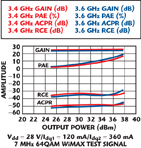In order to communicate with cellular phones and other wireless terminals, wireless communications base stations include an RF power amplifier which feeds a high frequency, high power signal to the external antennas. In today’s systems, the power amplifier function is generally designed by cascading and paralleling several RF transistors in order to achieve the necessary gain and power specifications. In the last ten years, RF laterally diffused metal oxide semiconductor (LDMOS) technology has been the dominant technique used to design RF power amplifiers. Currently, RF LDMOS technology is effectively a critical part of all 2G and 3G wireless communication systems.
From a product perspective, single stage discrete transistors offer a very flexible environment to design a power amplifier, as they offer numerous options for impedance matching, line up optimization and architectural choices. Counter to that, a line-up made of discrete elements is costly, consumes real estate and is prone to performance variation problems.
As an alternative to LDMOS discrete solutions, Freescale Semiconductor has been leading the way into RF integrated circuits, still based on LDMOS process technology. The addition of capacitor, inductor and resistor process modules compatible with the LDMOS process flow brings the capability to pack multiple RF stages, high impedance matching networks and additional useful analog functions into a single silicon chip. As LDMOS RFICs do not require any additional supply voltage, they can be used in conjunction with traditional discrete transistors or replace them entirely. They do not require any system level changes.
As more and more functionalities are concentrated on a single piece of silicon, LDMOS RFICs can be packaged with industry standard, cost-effective over-molded packaging technology. This creates a significant opportunity for cost reduction over traditional discrete transistors which are typically built with custom processes and materials. With initial focus on medium power driver applications, Freescale’s LDMOS IC portfolio now covers power levels up to 100 W at operating frequencies up to 2.1 GHz, making them an obvious choice for traditional applications such GSM, GSM EDGE, CDMA and W-CDMA. The MW7IC18100NB and MWE6IC9100NB products, both optimized for GSM EDGE applications, have been released to production in the early part of 2007.
Wireless communication standards evolve continuously to enable multimedia-centric applications and additional voice channels. In particular, WiMAX (Worldwide Interoperability for Microwave Access) technology has recently emerged as a potential disruptor in the wireless communication space. The WiMAX standard brings the promise of higher data rates, both in a fixed and mobile environment, thanks to orthogonal frequency division multiple access (OFDMA) modulation and straight Internet protocol compatibility. At the same time, WiMAX brings a new level of challenges in terms of the RF amplifier: this new modulation scheme creates a stringent linearity requirement for the power amplifier which also affects the RF device specifications. In addition, due to lack of available spectrum below 2 GHz, WiMAX systems will be deployed at frequencies ranging from 2.3 up to 3.8 GHz depending on the location. This clearly raises the bar on semiconductor manufacturers to keep performance (gain, efficiency, linearity) and cost in line with existing W-CDMA solutions, which are often used as reference points.
In order to enable future WiMAX networks, Freescale is releasing to the market a family of LDMOS RF integrated circuits, which have been specifically optimized for this application. The MW7IC2725N and MW7IC2750N cover frequencies ranging from 2.3 to 2.7 GHz, while the MW7IC3825N can be used from 3.3 to 3.8 GHz. All of these ICs are built into a multi-lead over-molded plastic package, and therefore can be produced in a cost-effective manner. Moreover, they come in different lead configurations enabling both insertion mounting (bolt down, reflow or clamping) and true surface mount. Finally, the over-molded assembly process results in very tight mechanical tolerances. As WiMAX amplifiers will be operating at frequencies close to 4 GHz in some cases, the mechanical aspect of the design becomes critical in order to maintain performance yields in a high volume environment.

Beside cost, another critical aspect of power amplifier design is RF performance. In order to match the performance benchmarks of traditional discrete transistors, the WiMAX ICs are designed by combining on-chip high quality passive components with Freescale’s seventh generation of LDMOS active transistors. Two stages of amplification are connected with a broadband inter-stage matching network. The input and output sections also include a matching network to raise the impedance level yet provide some flexibility to externally select the optimum source and load impedance values. External impedance matching in conjunction with bias current optimization of the first and second stages are important tuning factors to maximize the device performance under a given set of conditions. In particular, different settings can be chosen to operate these ICs as an output stage device with emphasis on power, gain and efficiency (see Figure 1) or as a linear driver device (see Figure 2).
These performance figures can not be directly compared to single-stage discrete solutions since ICs are effectively multi-stage, high gain solutions. Through methodical characterization of the output section of the IC device, performance parity with the latest generation of 2.7 and 3.8 GHz discrete transistors has been demonstrated. Freescale WiMAX ICs can be cascaded and paralleled to create attractive line-up configurations. They can be operated in class AB mode as well as in high efficiency Doherty mode, which greatly benefits from the high gain characteristic of these multi-stage devices.

The introduction of these initial RFICs for WiMAX base station applications sets the stage for future product development. The MW7IC2725N, MW7IC2750N and MW7IC3825N have good power capability but still do not match popular discrete transistors such as the MRF7S27130H (130 W) or the MRF7S38075 (75 W) in that respect. This creates an opportunity to design higher power IC solutions, as a key enabler to standardize WiMAX power amplifier architectures across all bands and all power levels.
Freescale Semiconductor Inc.
Austin, TX
(800) 521-6274
www.freescale.com
RS No. 300
